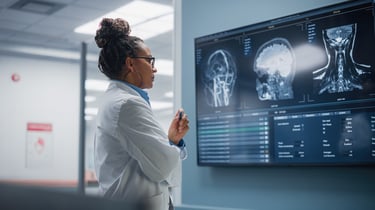 Hospitals produce 50 petabytes of data annually - equivalent to about 50 million gigabytes. If you imagine a standard DVD, which typically holds about 4.7 gigabytes of data, you would need over 10.6 million DVDs to store 50 petabytes. The sheer amount of information is so massive that it dwarfs ordinary datasets, underscoring the need for hospitals to leverage advanced technologies like AI to elevate diagnostics. The emerging technology can find patterns that point to the diagnoses doctors might overlook. However, as healthcare organizations look to integrate AI - with 86% already leveraging it in some capacity - the mounting emphasis on privacy and ethical considerations becomes imperative to protect patient data and comply with HIPPA laws.
Hospitals produce 50 petabytes of data annually - equivalent to about 50 million gigabytes. If you imagine a standard DVD, which typically holds about 4.7 gigabytes of data, you would need over 10.6 million DVDs to store 50 petabytes. The sheer amount of information is so massive that it dwarfs ordinary datasets, underscoring the need for hospitals to leverage advanced technologies like AI to elevate diagnostics. The emerging technology can find patterns that point to the diagnoses doctors might overlook. However, as healthcare organizations look to integrate AI - with 86% already leveraging it in some capacity - the mounting emphasis on privacy and ethical considerations becomes imperative to protect patient data and comply with HIPPA laws.
Here are some things to consider if your healthcare organization is considering using AI and ML to improve diagnostics.
Empowering Clinical Decisions with AI
Navigating patient care decisions can be stressful, particularly when doctors are pressed for time and managing multiple cases concurrently. AI tools can reduce the likelihood of forgetfulness, laboratory error, or incorrect diagnosis for doctors.
Many medical facilities use manual tools like the Modified Early Warning Score (MEWS), but today's AI tools are more accurate. By quickly processing large amounts of health record data, technology like this can transform healthcare.
However, AI tools must be integrated into the facility's current technology to be used effectively and co-exist with existing processes. Additionally, receiving buy-in from front-line employees in using the technology solution is vital to ensure seamless transition.
AI Assistance in Diagnostic Imaging
Another important application of AI is assisting technicians in interpreting Computed Tomography (CT) scans and other diagnostic imaging.
The millions of imaging procedures many facilities process in a year represent a significant amount of data that can be used to understand common and rare illnesses better and look for patterns in the images and diagnoses. Right now, the vast majority of hospital data goes unused, and machine learning solutions could change that, dramatically improving our understanding of how illnesses show up on imaging.
One thing to remember when you consider implementing advanced technology solutions is the energy required and how that can impact the environment. It's a good idea to consider implementing energy efficiency improvements and sourcing renewable energy to keep costs lower as your facility takes advantage of new tech solutions.
Using AI and ML to Overcome Bias
One of the most exciting potential benefits of using AI and ML in diagnostics is that it can overcome biases that are all too common in medicine. While doctors don't intend to minimize symptoms or misdiagnose patients, unconscious bias leads to significant health disparities. Implicit or unconscious bias is very common, and doctors are not immune. A recent government study found that white Americans received better care than Black and Native Americans for 40% of the quality metrics measured.
AI and ML can allow patients to be analyzed based on data alone, without bias based on appearance, economic status, gender, or age - dramatically improving the quality of care in medical facilities for everyone.
However, it's important that the machine learning software is "trained" properly, or it will incorporate the same biases that doctors already exhibit. Reviewing results and checking for disparities based on race, gender, and other common bias categories can help ensure human bias isn't built into the AI system.
How to Implement New AI Technology
If your medical facility has decided to implement a new AI technology solution, you're likely excited and nervous. Technology projects are often complex and require considerable commitment from facility leadership and front-line employees.
One of the best ways to start such a big project is to know exactly what the facility is trying to improve. Knowing your goals will help you choose the right tech solution and compellingly explain the new technology to employees. One of the best goal-setting strategies is to set SMART goals, meaning Specific, Measurable, Achievable, Relevant, and Time-bound. SMART goals help guide your organization away from vague aspirations, ensuring clarity that sparks action and commitment to new technology.
It's also essential to involve all stakeholders in setting goals, evaluating solutions, and implementing the AI solution. That way, everyone will feel heard, and there won't be unspoken resistance to implementing the change.
AI and Machine Learning Can Improve Diagnostics FOR THE FUTURE
Modern AI and ML tools hold promise in leveraging health data for enhanced diagnostics, treatment plans, and bias reduction in healthcare. Nevertheless, addressing concerns such as patient privacy, robust cybersecurity, energy efficiency, and programming bias during training will be crucial in activating the full potential of AI. The good news is that the benefits are significant, and with foresight and wisdom, the concerns can be managed to improve patient outcomes worldwide.
About the Author: Miles is an independent writer with a background in business and a passion for tech, psychology, news, and simply helping people live happy and fulfilled lives. He has lived and traveled all over the United States and continues to expand his awareness and experiences. When not writing, he is most likely mountain biking or kicking back with a cup of tea.



